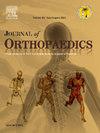Evaluation of retear rates following transtibial anterior cruciate ligament reconstruction: Functional outcomes and GNRB assessment with a mean 6.3 follow-up
IF 1.5
Q3 ORTHOPEDICS
引用次数: 0
Abstract
The method of reconstruction of the anterior cruciate ligament (ACL) using the tibia-dependent femoral tunnel technique is highly criticized. It would not allow anatomical placement of the graft and would therefore lead to a high rate of retear. This retrospective study aimed to evaluate the rate of retear in ACL reconstructions using the transtibial tunnel (TT) technique and assess functional outcomes. The study included 148 patients (153 knees) who underwent ACL reconstruction with a minimum two-year follow-up period. Patients underwent clinical examinations, completed functional questionnaires (KOOS, Lysholm, ACL-RSI), and underwent laximetry measurements with GNRB at 134 N and 200 N. Two patients had retears detected on MRI and underwent revision surgery prior to the study, leaving 151 knees for evaluation. The retear rate was 6.6 %, with an overall rate of 7.8 % when including revision cases. Laxity measurements obtained with GNRB showed a strong correlation with functional scores, indicating worse scores with greater laxity differences (p < 0.0001). The retear rate observed in this study was at the higher end of those reported in the literature. The study indications for TT ACL reconstructions must be defined more specifically to reduce failure rates.
Level of evidence: III (retrospective cohort study).
评估经胫骨前十字韧带重建术后的再撕裂率:平均 6.3 次随访的功能结果和 GNRB 评估
使用胫骨-股骨隧道技术重建前十字韧带(ACL)的方法备受批评。这种方法无法按解剖学原理放置移植物,因此会导致较高的再撕裂率。这项回顾性研究旨在评估使用经胫骨隧道(TT)技术进行前交叉韧带重建的再撕裂率,并评估功能效果。研究纳入了 148 名接受前交叉韧带重建术的患者(153 个膝关节),随访期至少两年。患者接受了临床检查,填写了功能问卷(KOOS、Lysholm、ACL-RSI),并在 134 N 和 200 N 下接受了 GNRB 的松弛测量。两名患者在核磁共振成像上发现了再撕裂,并在研究前接受了翻修手术,因此有 151 个膝关节接受了评估。再撕裂率为 6.6%,包括翻修病例在内的总体再撕裂率为 7.8%。用 GNRB 测量的松弛度与功能评分有很强的相关性,表明松弛度差异越大,评分越差(p < 0.0001)。本研究中观察到的再撕裂率在文献报道中处于较高水平。必须更明确地界定TT前交叉韧带重建的研究适应症,以降低失败率:证据等级:III(回顾性队列研究)。
本文章由计算机程序翻译,如有差异,请以英文原文为准。
求助全文
约1分钟内获得全文
求助全文
来源期刊

Journal of orthopaedics
ORTHOPEDICS-
CiteScore
3.50
自引率
6.70%
发文量
202
审稿时长
56 days
期刊介绍:
Journal of Orthopaedics aims to be a leading journal in orthopaedics and contribute towards the improvement of quality of orthopedic health care. The journal publishes original research work and review articles related to different aspects of orthopaedics including Arthroplasty, Arthroscopy, Sports Medicine, Trauma, Spine and Spinal deformities, Pediatric orthopaedics, limb reconstruction procedures, hand surgery, and orthopaedic oncology. It also publishes articles on continuing education, health-related information, case reports and letters to the editor. It is requested to note that the journal has an international readership and all submissions should be aimed at specifying something about the setting in which the work was conducted. Authors must also provide any specific reasons for the research and also provide an elaborate description of the results.
 求助内容:
求助内容: 应助结果提醒方式:
应助结果提醒方式:


